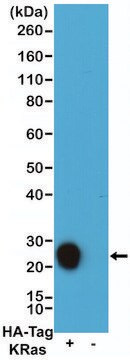ABT1834
Anti-Neurexin-1
Synonim(y):
Neurexin I-alpha; Neurexin 1-alpha
About This Item
Polecane produkty
pochodzenie biologiczne
chicken
Poziom jakości
forma przeciwciała
purified antibody
rodzaj przeciwciała
primary antibodies
masa cząsteczkowa
calculated mol wt 166.17 kDa
observed mol wt ~170 kDa
oczyszczone przez
affinity chromatography
reaktywność gatunkowa
mouse, human
reaktywność gatunkowa (przewidywana na podstawie homologii)
rat
opakowanie
antibody small pack of 100 μL
metody
electron microscopy: suitable
immunofluorescence: suitable
western blot: suitable
izotyp
IgY
sekwencja epitopowa
C-terminal
numer dostępu Protein ID
numer dostępu UniProt
temp. przechowywania
-10 to -25°C
docelowa modyfikacja potranslacyjna
unmodified
informacje o genach
mouse ... Nrxn1(6262)
Opis ogólny
Specyficzność
Immunogen
Zastosowanie
Evaluated by Western Blotting in Human brain tissue lysate.
Western Blotting Analysis: A 1:1,000 dilution of this antibody detected Neurexin-1 in Human brain tissue lysate.
Tested Applications
Western Blotting Analysis: A 1:1,000 dilution from a representative lot detected Neurexin-1 in lysates from HEK293 cells and Mouse brain tissue.
Electron Microscopy: A representative lot detected Neurexin-1 in Electron Microscopy applications (Taniguchi, H. et al. (2007). J Neurosci. 27(11): 2815-2824).
Immunofluorescence Analysis: A representative lot detected Neurexin-1 in Immunofluorescence applications (Dean, C. et al. (2003). Nat Neurosci. 6, 708-716).
Note: Actual optimal working dilutions must be determined by end user as specimens, and experimental conditions may vary with the end user.
Postać fizyczna
Rekonstytucja
Przechowywanie i stabilność
Inne uwagi
Oświadczenie o zrzeczeniu się odpowiedzialności
Nie możesz znaleźć właściwego produktu?
Wypróbuj nasz Narzędzie selektora produktów.
Kod klasy składowania
12 - Non Combustible Liquids
Klasa zagrożenia wodnego (WGK)
WGK 1
Temperatura zapłonu (°F)
Not applicable
Temperatura zapłonu (°C)
Not applicable
Certyfikaty analizy (CoA)
Poszukaj Certyfikaty analizy (CoA), wpisując numer partii/serii produktów. Numery serii i partii można znaleźć na etykiecie produktu po słowach „seria” lub „partia”.
Masz już ten produkt?
Dokumenty związane z niedawno zakupionymi produktami zostały zamieszczone w Bibliotece dokumentów.
Nasz zespół naukowców ma doświadczenie we wszystkich obszarach badań, w tym w naukach przyrodniczych, materiałoznawstwie, syntezie chemicznej, chromatografii, analityce i wielu innych dziedzinach.
Skontaktuj się z zespołem ds. pomocy technicznej